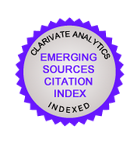A predictive machine learning model for virtual screening of potential inhibitors against Mycobacterium tuberculosis
https://doi.org/10.29235/1561-8323-2025-695-5-367-375
Abstract
A boosting-based ensemble machine learning model that utilizes molecular descriptors as input data has been developed to predict the values of binding free energy of small-molecule compounds to the MmpL3 of Mycobacterium tuberculosis (Mtb), an essential mycolic acid and lipid transporter required for growth and cell viability. Testing this model on two large sets of structurally heterogeneous molecules via regression evaluation metrics MAE, MSE, R2, and R showed that it is comparable in predictive performance to the Vina scoring function of the QuickVina 2 molecular docking program, but allows one to significantly speed up the structure-based virtual screening, which is an important factor in the analysis of molecular libraries containing hundreds of thousands, and occasionally millions, of chemical structures. In this regard, the developed model can be used as an express method for the rapid selection of candidate compounds in chemical databases, followed by prediction of their poses in the MmpL3 binding site using molecular docking and a study of the stability of ligand/MmpL3 complexes via molecular dynamics methods. The results obtained demonstrate the high efficiency of the developed model and its significant potential for the use in virtual screening of candidate compounds with antibacterial action based on the inhibition of the MmpL3 protein of Mycobacterium tuberculosis, one of the priority therapeutic targets for the design of new effective therapeutics against drug-resistant tuberculosis.
Keywords
About the Authors
G. M. BashkoBelarus
Bashko Georgy M. – Student.
4, Nezavisimosti Ave., 220030, Minsk
Yu. V. Kornoushenko
Belarus
Kornoushenko Yuri V. – Ph. D. (Chemistry), Senior Researcher.
5/2, Kuprevich Str., 220084, Minsk
A. V. Tuzikov
Belarus
Tuzikov Alexander V. – Corresponding Member, D. Sc. (Physics and Mathematics), Professor, Head of the Laboratory.
6, Surganov Str., 220012, Minsk
A. M. Andrianov
Belarus
Andrianov Alexander M. – D. Sc. (Chemistry), Professor, Chief Researcher.
5/2, Kuprevich Str., 220084, Minsk
References
1. Deore A. B., Dhumane J. R., Wagh R., Sonawane R. The stages of drug discovery and development process. Asian Journal of Pharmaceutical Research and Development, 2019, vol. 7, no. 6, pp. 62–67. https://doi.org/10.22270/ajprd.v7i6.616
2. Berdigaliyev M., Aljofan N. An overview of drug discovery and development. Future Medicinal Chemistry, 2020, vol. 12, no. 10, pp. 939–947. https://doi.org/10.4155/fmc-2019-0307
3. Roney M., Mohd Aluwi M. F. F. The importance of in-silico studies in drug discovery. Intelligent Pharmacy, 2024, vol. 2, no. 4, pp. 578–579. https://doi.org/10.1016/j.ipha.2024.01.010
4. Shaker B., Ahmad S., Lee J., Jung C., Na D. In silico methods and tools for drug discovery. Computers in Biology and Medicine, 2021, vol. 137, art. 104851. https://doi.org/10.1016/j.compbiomed.2021.104851
5. Mouchlis V. D., Afantitis A., Serra A., Fratello M., Papadiamantis A. G., Aidinis V., Lynch I., Greco D., Melagraki G. Advances in de novo drug design: from conventional to machine learning methods. International Journal of Molecular Sciences, 2021, vol. 22, no. 4, art. 1676. https://doi.org/10.3390/ijms22041676
6. Khawbung J. L., Nath D., Chakraborty S. Drug resistant tuberculosis: a review. Comparative Immunology, Microbiology and Infectious Diseases, 2021, vol. 74, art. 101574. https://doi.org/10.1016/j.cimid.2020.101574
7. Stokes J. M., Yang K., Swanson K., Jin W., Cubillos-Ruiz A., Donghia N. M., MacNair C. R., French S., Carfrae L. A., Bloom-Ackermann Z., Tran V. M., Chiappino-Pepe A., Badran A. H., Andrews I. W., Chory E. J., Church G. M., Brown E. D., Jaakkola T. S., Barzilay R., Collins J. J. A deep learning approach to antibiotic discovery. Cell, 2020, vol. 180, no. 4, pp. 688– 702. https://doi.org/10.1016/j.cell.2020.01.021
8. Almeleebia T. M., Shahrani M. A., Alshahrani M. Y., Ahmad I., Alkahtani A. M., Alam M. J., Kausar M. A., Saeed A., Saeed M., Iram S. Identification of new Mycobacterium tuberculosis proteasome inhibitors using a knowledge-based computational screening approach. Molecules, 2021, vol. 26, no. 8, art. 2326. https://doi.org/10.3390/molecules26082326
9. Zheng S., Gu Ya., Gu Yu., Zhao Y., Li L., Wang M., Jiang R., Yu X., Chen T., Li J. Machine learning-enabled virtual screening indicates the anti-tuberculosis activity of aldoxorubicin and quarfloxin with verification by molecular docking, molecular dynamics simulations, and biological evaluations. Briefings in Bioinformatics, 2024, vol. 26, no. 1, art. bbae696. https://doi.org/10.1093/bib/bbae696
10. Felker I. G., Gordeeva E. I., Stavitskaya N. V., Pershina V. A., Batyrshina Ya. R. Prospects and obstacles for clinical of the inhibitors of Mycobacterium tuberculosis efflux pumps. Biologicheskie membrany = Biological Membranes, 2021, vol. 38, no. 5, pp. 317–339 (in Russian).
11. Imran M., Arora M. K., Chaudhary A., Khan S. A., Kamal M., Alshammari M. M., Alharbi R. M., Althomali N. A., Alzimam I. M., Alshammari A. A., Alharbi B. H., Alshengeti A., Alsaleh A. A., Alqahtani S. A., Rabaan A. A. MmpL3 inhibition as a promising approach to develop novel therapies against tuberculosis: a spotlight on SQ109, clinical studies, and patents literature. Biomedicines, 2022, vol. 10, no. 11, art. 2793. https://doi.org/10.3390/biomedicines10112793
12. Luo Q., Duan H., Yan H., Liu X., Peng L., Hu Y., Liu W., Liang L., Shi H., Zhao G., Hu J. Specifically targeting Mtb cell-wall and TMM transporter: the development of MmpL3 inhibitors. Current Protein and Peptide Science, 2021, vol. 22, no. 4, pp. 290–303. https://doi.org/10.2174/1389203722666210421105733
13. Sparks I. L., Derbyshire K. M., Jacobs Jr. W. R., Morita Y. S. Mycobacterium smegmatis: the vanguard of mycobacterial research. Journal of Bacteriology, 2023, vol. 205, no. 1, art. e00337-22. https://doi.org/10.1128/jb.00337-22
14. Lipinski C. A., Lombardo F., Dominy B. W. Feeney P. J. Experimental and computational approaches to estimate solubility and permeability in drug discovery and development settings. Advanced Drug Delivery Reviews, 2001, vol. 46, no. 1–3, pp. 3–26. https://doi.org/10.1016/S0169-409X(00)00129-0
15. Sterling T., Irwin J. J. ZINC 15 – ligand discovery for everyone. Journal of Chemical Information and Modeling, 2015, vol. 55, no. 11, pp. 2324–2337. https://doi.org/10.1021/acs.jcim.5b00559













































